

Keywords: Ultrasonic Testing, Condition Monitoring Location (CML), Thickness Monitoring Location (TML), Artificial Intelligence of Things (AIoT), Industrial Internet of Things (IIoT), ARC Advisory Group.
Savvy industrial facility decision-makers have been shifting away from manually intensive corrosion monitoring methods of the 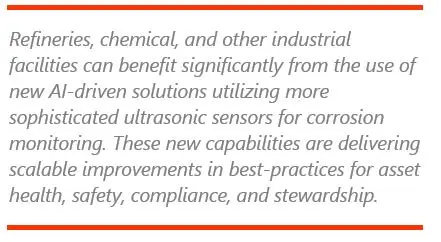 past and moving toward greater utilization of IIoT and Industry 4.0 approaches, resulting in sustainable operational and safety benefits, along with a more engaged, data-driven, and stewardship focused culture.
past and moving toward greater utilization of IIoT and Industry 4.0 approaches, resulting in sustainable operational and safety benefits, along with a more engaged, data-driven, and stewardship focused culture.
These leaders include decision-makers at refineries, chemical, and other process facilities, and asset-intensive industries. They are reducing risks and enabling significant operational and cost saving improvements by replacing traditional techniques for corrosion monitoring with the new capabilities. Corrosion monitoring enables operational, safety, and stewardship goals to be met despite the negative impacts of corrosion on critical equipment and components.
Corrosion is a failure mechanism which causes leaks, but also degrades plant performance and leads to unplanned operational interruptions that can range from minor to catastrophic. Improvements that reduce the negative impacts of corrosion not only help avoid these high-cost exceptions, but also help to extend the life of critical equipment, including pipes, pipelines, vessels, and tanks in refineries, polymer plants, and other asset-intensive industrial facilities.
Traditionally, corrosion monitoring through non-destructive testing (NDT), is led by highly qualified professionals, utilizing deep expertise to identify and solve complex issues. Corrosion inspectors leverage various NDT and non-destructive evaluation (NDE) methods to assess equipment damage, and periodically monitor changes due to corrosion to inform decisions for remaining 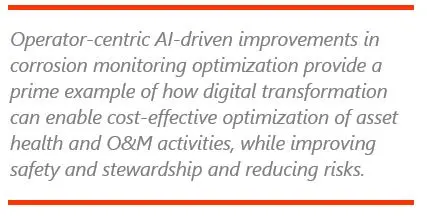 equipment life evaluations. These insights have traditionally played a crucial role in optimizing production and enhancing personnel and environmental safety.
equipment life evaluations. These insights have traditionally played a crucial role in optimizing production and enhancing personnel and environmental safety.
A key element in the efforts of corrosion-related inspections is to take measurements at critical locations where the likelihood of elevated corrosion rates is high, including pipe elbows and the transition zone between gas and liquid within pressure vessels, and other locations where known mechanisms of erosion and/or corrosion occur. The locations that are considered critical to obtain asset health information are called Thickness Monitoring Locations (TMLs), or the newer related term, Condition Monitoring Location (CML).
In the absence of a continuous monitoring capability for crucial data as part of a robust platform, advancements in corrosion monitoring have tended to lag other areas benefiting from enhanced analytics to inform Operations and Maintenance (O&M) practices effectively. Over recent decades, Asset Integrity Management (AIM) solutions, coupled with advanced analytics, have ushered in parallel improvements across diverse O&M domains. This spans critical aspects such as O&M during major planned plant outages, optimization of predictive maintenance models for fixed equipment, and the streamlining of work orders for field crew O&M activities. In service-level-dependent industries like utilities, success hinges on the seamless integration of supply chain, inventory, and inter-connected workflows.
The use of ultrasonic testing (UT) involving ultrasonic inspection methods to monitor internal corrosion of pipes and pressure vessels is similar to the familiar process of ultrasonic imaging in the medical profession. In industrial applications, ultrasonic probes, software, and analytics are used for a wide range of testing and diagnostic procedures, from inspecting welds to determining the cause of failures of components, as well as the critical maintenance functions of corrosion monitoring.
Traditionally, in the case of corrosion monitoring, ultrasonic probes have for many years been used by inspectors in several different use cases, including:
The use of portable ultrasonic scanners helps identify areas along pipelines where potential failures or leaks may occur. This allows for a focused and more detailed inspection in areas where it will be of the greatest benefit. The use of ultrasonic thickness probes for specific sections of pipes and elbows and pressure vessels where corrosion and erosion need to be monitored in greater detail.
The NDT and NDE of assets and components for reliability testing and failure analysis.
Developments in corrosion monitoring, demonstrated by Inspection Data Management Systems (IDMS), have progressed in tandem with the broader evolution of plant operations and maintenance (O&M) systems. This evolution traces a path from the 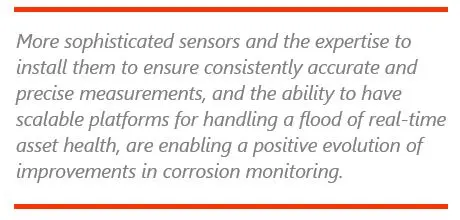 periodic maintenance management protocols of early Computerized Maintenance Management Systems (CMMS) to subsequent advancements like Enterprise Asset Management (EAM) and Asset Integrity Management (AIM) solutions. In this trajectory, maintenance has ideally shifted towards data-driven predictive models, mitigating the drawbacks of schedules that often resulted in over- or under-maintenance of assets.
periodic maintenance management protocols of early Computerized Maintenance Management Systems (CMMS) to subsequent advancements like Enterprise Asset Management (EAM) and Asset Integrity Management (AIM) solutions. In this trajectory, maintenance has ideally shifted towards data-driven predictive models, mitigating the drawbacks of schedules that often resulted in over- or under-maintenance of assets.
Shifting the focus of maintenance management, specifically in the realm of corrosion monitoring, to prioritize asset health rather than merely minimizing failures can trigger a positive cultural shift. Placing asset health at the center of operations and maintenance practices cultivates a culture where O&M best practices are geared towards ensuring the well-being of assets. To further move corrosion monitoring into a similar higher echelon of optimization, ultrasonic sensors were installed permanently in refineries and other facilities, but the results have been mixed, for the reasons detailed below.
It is no simple matter to convert data from ultrasonic measurements to provide reliable and accurate insights on rates of internal corrosion, especially with the relatively low consistency and reliability of manual ultrasonic corrosion monitoring inspection processes but also with existing permanently installed solutions.
Important symptoms of shortfalls in addressing challenges include:
Insufficient accuracy in the determination of average thickness at TMLs, whereby the data going into the model was not yielding consistent results.
Low precision of the results, which yielded high variability above and below the calculated average value.
When corrosion thins the inner wall of a pipe, sub-optimal corrosion monitoring solutions can be error prone and fail to detect that loss of material accelerated since the last reading—such errors can even mistakenly conclude that an inner pipe wall has thickened, when it has, instead, thinned, since the last measurement, due to inaccurate input data and/or incorrect modelling of reflected ultrasonic signals off the interior of the thinner wall.
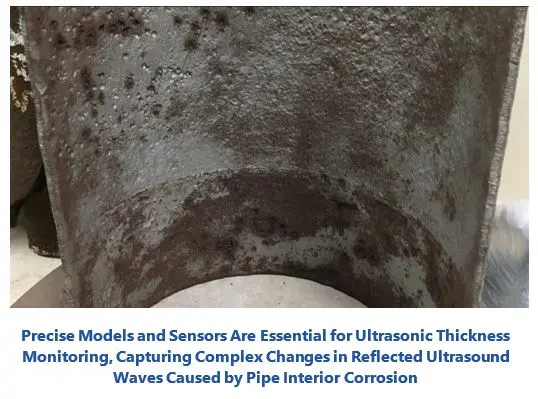 The outcomes associated with these shortfalls can range from minor equipment outages to catastrophic failures and tend to drive higher costs and higher levels of operational risks associated with under- or over- maintaining assets, and sub-optimal allocation of personnel and resources, which can also lead to regulatory, as well as operational, risks and liabilities.
The outcomes associated with these shortfalls can range from minor equipment outages to catastrophic failures and tend to drive higher costs and higher levels of operational risks associated with under- or over- maintaining assets, and sub-optimal allocation of personnel and resources, which can also lead to regulatory, as well as operational, risks and liabilities.
The coupling between the outside of the pipe or tank, and the ultrasonic piezoelectric transducer, needs to be consistent from one measurement to the next, and the firmness of mounting especially on small diameter piping to avoid wobbling, also needs to not vary. Otherwise, the resulting variations introduced into the ultrasonic sensor’s measurements will not be sufficiently reliable for the data to provide an accurate and precise result.
In addition, the dynamics of corrosion are not linear, and as the inner wall thickness is reduced by corrosion the ultrasonic reflection patterns are altered in ways which only the most sophisticated models can interpret correctly. And the mounting of the sensors must be aligned in a consistent and reliable way to ensure the predictive model works well.
The goals of corrosion monitoring ideally should include enablement of accurate prediction of corrosion rates and amount of metal loss, which in turn should enable accurate determination of the remaining safe useful life of the asset, along with the optimal related future inspection intervals. These goals were not always met, because there are many technical and operational hurdles, which must be addressed to avoid shortfalls.
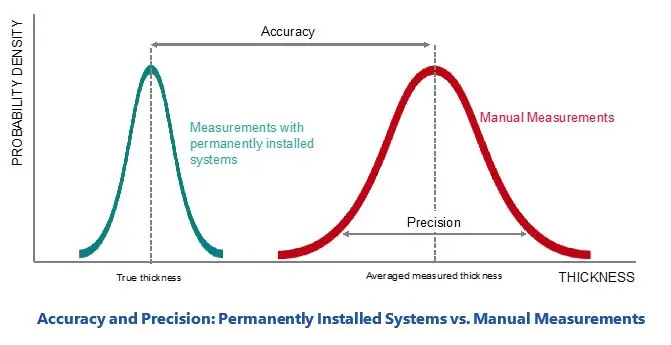
Recent, more sophisticated implementations, involving the installation of groups of permanent sensors, have encountered additional challenges even after overcoming the above-mentioned difficulties. These setbacks can be attributed to various reasons:
While permanent sensor installations are a key element of the needed foundation, the ideal solution must also support automation and advanced analytics and higher quality data.
The models required to generate accurate insights require the installation of more advanced sensors that correct for temperature variations, thereby providing the needed data to determine when accelerated rates of corrosion, or material velocity, to meet compliance requirements associated with better determination of actual asset life and safe operating parameters.
If the plant operator, rather than the service provider, is responsible for maintenance of the sensors, after some period of time, some of the sensors that should be replaced may not be replaced.
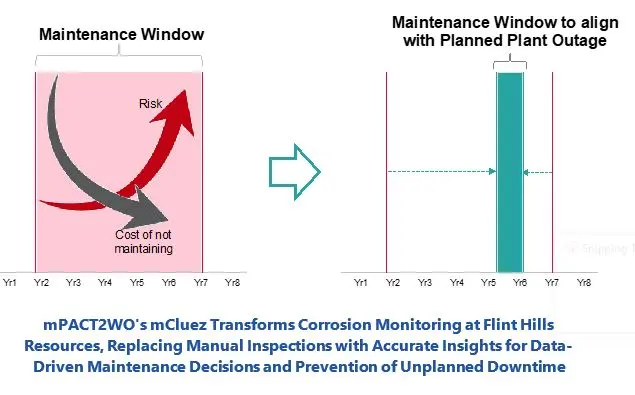
These pitfalls in turn have historically run in parallel with how easy it can be to take a short-term viewpoint, one where operators fall prey to a “one-off” approach. Admittedly, there may seem to be good logic behind the temptation to focus on a few problem areas, e.g., where certain plant areas have TML locations that are difficult or unsafe for inspectors to access. But historically, such installations tended to suffer when there was not a comprehensive plan to maintain the permanent sensors because the “one-off” project did not employ the latest sensor technologies or leverage SMEs with robust processes to ensure the installations provide accurate insights as part of an optimized automated, scalable approach.
Among these “lessons learned” is another kind of “one-off” pitfall where later installations did not have the needed platform or service provider to fully leverage more highly accurate data. There is a great deal of expertise required to contextualize the incoming data to ensure the required levels of input quality continue, to enable the required precision and accuracy of the output. The desired results of an optimal system may not materialize for the following reasons:
Lack of use (or poor installation of) higher-quality sensors.
A compromising of the ability of the advanced analytics tools and models to deliver the highly accurate results that are needed, due to TMLs and/or data platforms not having been optimized.
Corrosion is a complex, non-linear process, one which has negative cost, operational, and/or regulatory compliance outcomes when model predictions yield inaccurate remaining asset life predictions. The safe remaining life of a pipe or tank or pressure vessel will not be predicted accurately if less sophisticated models are employed, or if the sensor data is inaccurate. The sensor must correct for temperature variations and must be coupled properly and precisely mounted at the optimal TMLs. Otherwise, calculations of corrosion rates and remaining asset life and needed repair/replace/ or maintenance activities, will be unreliable, and create liabilities and unexpectedly higher O&M costs.
The ideal solution should also:
Provide the best possible visualization tools.
Display results on simplified and easy to use dashboards.
Have supporting technology underlying the solution in terms of data science and software and platform to ensure scalability and successful lasting uptake across facilities in large scale deployments.
Greater value is now available from a continuous monitoring system designed as part of a robust AIoT driven platform. This greater value is important, even though insights in the past have traditionally been provided by nondestructive testing (NDT) and nondestructive evaluation (NDE) methods for corrosion monitoring. While traditional methods of the past provided valuable insights into the condition of materials and structures, those methods have not been designed with a focus on asset health and overall operational excellence but instead have been primarily focused on assessing the current damage state of equipment, detecting corrosion, and evaluating the remaining life of assets.
ARC Advisory Group sees Next-Gen developments optimizing corrosion monitoring as part of wider trends associated with AIoT solutions, the convergence of artificial intelligence and the Industrial Internet of Things (IIoT). It is also an element of related smart safety solutions that increase safety performance and resilience.
Taking an AIoT perspective puts key questions which operators need to ask themselves into sharp relief, in a way best centered around the replacement of prior static points of view with a deeper understanding of the moving targets that must now be addressed.
Across the spectrum of oil and gas operations, from upstream to midstream and downstream, AI driven optimization of corrosion monitoring capabilities is providing increasingly valuable direct and indirect benefits. The less accurate methods of the past led to direct unnecessary costs, as well as negative operational impacts, associated with over maintenance of assets. As a result, it is optimal to postpone unnecessary repair/replace work which would mistakenly have been done close to the beginning of a maintenance interval. Delaying repairs within the maintenance window raises the risk of corrosion-induced leaks, unplanned outages due to minor equipment failures, or even major failures. As such, timely repairs are essential to prevent these issues. Highly accurate data enables precise prediction of the remaining operational life window, aligning it seamlessly with the appropriate outage window for optimal planning and maintenance strategies.
A recent example of an AIoT-driven corrosion monitoring solution is mCluez from mPACT2WO, a Molex business. This AIoT-driven solution ensures better data-driven decision-making processes, by using permanently installed monitoring systems which enable a reliable, accurate, precise, and automated system whose results provide accurate insights about actual wall thicknesses and remaining asset life.
The accuracy of TML measurements using manual inspections (at 0.03”) is vastly improved by transitioning to the higher accuracy of the latest automated sensor-enabled monitoring (at 0.001”) solutions. These solutions provide fertile ground for significant improvements.
The mCluez solution for corrosion monitoring is being utilized at Flint Hills Resources, where it has been helping maintenance activities to be optimized and asset life to be extended. Flint Hills Resources is among the top ten largest US refiners with operations primarily in the Midwest and Texas. Along with the mCluez solution for corrosion monitoring, Flint Hills Resources has also been a user of the mRegz™ AirCompliance solution from mPACT2WO for leak detection and emissions monitoring (per the May 2023 ARC White paper, AI-Driven Leak Detection Trends).
ARC Advisory Group sees recent AIoT-driven improvements in corrosion monitoring as a valuable “win/win” opportunity when 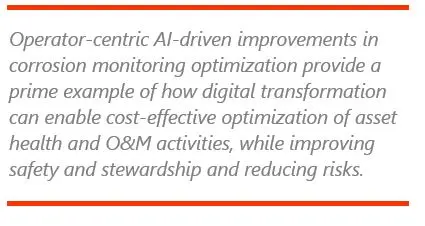 implemented in an operator-centric way. Projects which take an “operator first” approach will provide a solid foundation for success, where these new capabilities are embraced with a sense of ownership rather than being viewed as having been imposed externally with lack of solid buy-in.
implemented in an operator-centric way. Projects which take an “operator first” approach will provide a solid foundation for success, where these new capabilities are embraced with a sense of ownership rather than being viewed as having been imposed externally with lack of solid buy-in.
Scalable and lasting benefits realization depends upon maintenance of best practices from the start. This is best achieved by working with a solution provider who is qualified from a people, process, and technology point of view. By having a trusted partner relationship with the solution provider, the needed depth of collaborations can be leveraged.
Collaborations enable optimal selection of TMLs, and installation of sensors to help ensure the resulting implementation is founded on reliable information to inform decisions about the best actions to take to prevent or minimize the damage caused by corrosion. Such implementations also facilitate automation of data-driven workflows which form the basis for optimal asset management, operational excellence, and ongoing improvements in safety, cost, compliance, and maintenance management performance. Alignment of service offerings should be approached from a business standpoint as well as a technology standpoint. Technology is an enabler for business value.
ARC Advisory Group clients can view the complete report at the ARC Client Portal.
Please Contact Us if you would like to speak with the author.
Obtain more ARC In-depth Research at Market Analysis

